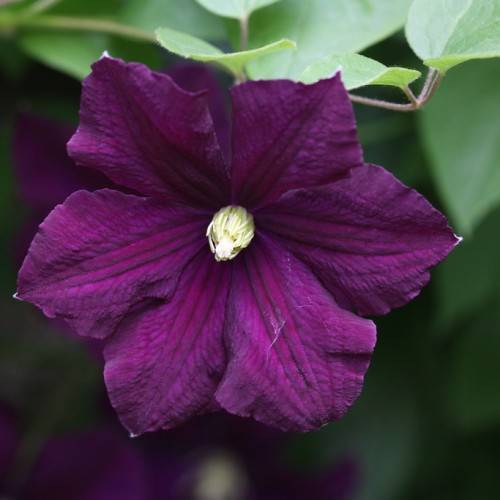
clematis
Clematis 'Etoile Violette'
Cycle:
Perennial
Watering:
Average
Hardiness Zone:
4 - 8
Flowers:
Flowers
Sun:
Full sun,part shade
Leaf:
Yes
Growth Rate:
High
Maintenance:
Low
Care Level:
Medium
watering
Water Clematis 'Etoile Violette' approximately every 3 to 4 days in the summer months and once per week in the cooler months. Water deeply, focusing the water at the base of the plant. During extended periods of dry weather you may need to increase regular watering, aiming for moist but not wet soils. Maintaining moist soil is especially important in the early months of spring, to help establish vigorous growth. When the temperatures start to rise in late spring and summer, reduce the amount of watering, especially on established plants. Over-watering can cause root rot.
sunlight
Clematis 'Etoile Violette' needs full to partial sunlight for ideally 6- 8 hours a day in order to thrive. While it can tolerate partial shade, it will produce more flowers with direct sunlight. This means that it should be placed in a sunny spot that is sheltered from the wind, in order to ensure the best blooms. Additionally, Clematis 'Etoile Violette' should be watered regularly for optimal development.
pruning
Pruning a Clematis 'Etoile Violette' can help it become a vigorous and well-branched plant. Pruning should be done in early spring, before new growth begins. It is best to prune back vigorous shoots to near ground level. For plants grown in less sheltered areas, the shoots can be pruned hard in late winter, and at least 2-thirds of the top growth can be cut off at the same time. This encourages fewer, but more robust growths for more abundant flowering. Pruning should be done with sharp pruning shears and always cut just above a pair of leaf buds. Dead or damaged stems should be removed as they appear.
FAQ
Can Clematis plants grow in pots?
Yes, Clematis plants can definitely be grown in pots. When planting a Clematis in a pot make sure to use a larger size pot with drainage holes and fill it with a mix of well-draining potting soil and compost. Ensure to keep the root area cool and the pot in a sunny location while providing regular water and fertilization. Check the plant almost daily to make sure it is not becoming too dry. Clematis can do well in a pot and with the right care and conditions, they will thrive.
Are Clematis plants self-pollinating?
No, clematis plants are not self-pollinating. Clematis plants need pollinators such as bees, butterflies, moths and other insects to transfer pollen from the male anthers to the female stigma of the flower in order to produce viable seed. Pollination must also occur within relatively close proximity of the same species in order to create viable hybrid plants.
Can Clematis plants be grown as a houseplant?
Yes, Clematis plants can be grown as a houseplant. It is best to grow them in a pot with full sun and a soil that is rich in organic material and retains moisture. When potting the plant, place a stake or trellis next to the pot so that the vine can climb when it begins to grow. Be sure to water your Clematis plant regularly to keep it healthy and growing. Additionally, keep an eye out for pests and treat with natural insecticides as necessary.
Could Clematis plants survive in a colder climate?
Yes, Clematis plants can survive in colder climates with proper preparation. If planted in the fall, proper mulching should be done to protect the roots from cold temperatures. If planted in the spring, they should be watered frequently to help them adjust to the cooler temperatures more quickly. If temperatures drop below -20°C ( -4°F), additional measures may need to be taken such as the application of protective wraps and thermal insulation. Additionally, plants in exposed areas should be protected from the wind to prevent excessive dehydration. With the right measures in place, Clematis plants can easily survive in colder climates.
Could Clematis plants be grown in a greenhouse?
Yes, clematis plants can be grown in a greenhouse. Due to their vine-like growth habit and tropical native origins, clematis plants thrive in the moist and warm environment of a greenhouse. Clematis are generally grown from cuttings or from dividing existing plants, and benefit from regular pruning and fertilizing. They will also enjoy the indirect light of a greenhouse and the protection from strong winds and temperatures that the humidity and contained environment provides.
